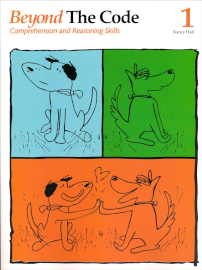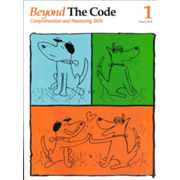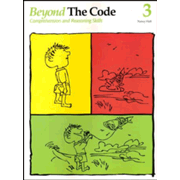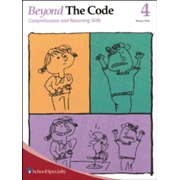The Beyond The Code series provides reading practice and teaches reading comprehension and reasoning skills. It is the perfect complement for the Explode The Code® series, and it will also work alongside other resources that teach reading based on phonics.
The books are numbers 1, 2, 3, and 4, designating the order in which they are to be used rather than grade levels. There are no teacher guides or answer keys, but the answers should be obvious.
Each book features a number of stories that children will read. The stories are creative and often far-fetched, and they are usually written with poetic elements, such as end rhymes, internal rhymes, assonance, and alliteration. Here’s an excerpt from the story “Max” in the second book:
Max was only two, but his Mom and Dad said,
What can we do?” Max like to mess in mud and muck
and stuff. And that is not at all good to do.”
But Max did not care; he was only two!
Both the stories and the exercises are accompanied by black-and-white drawings that are often quite whimsical, in keeping with the stories themselves.
The exercises in each book center around each of the stories. Before children read a story, they complete at least two exercises that help them review the vocabulary that will be used in the story. These exercises usually include explanations for new words, space for children to write the words, and pictures to match with sentences that use the words.
The stories are followed by a variety of exercises where children might match columns, draw, or write words or sentences. They work on skills such as reading comprehension, identifying related words, writing plural forms of words, assigning words to categories, ordering events in a story, and identifying synonyms. “Think About It!” is the one consistent exercise included after every story. Think About It! presents a number of questions that relate to the story but require analysis, inferences, and other extended thinking beyond the story. For instance, on page 46 of the third book, two of the questions posed are, “How are shoes and socks alike?” and “Why was Kal sad that he could not go to school?” Both questions are related to content within the story, but they are not simple comprehension questions. (Parents might need to assist children as they write complete sentences to answer these questions.)
Beyond The Code: 1 uses vocabulary words with both long and short vowels, including challenging words such as why, door, and they. It can be used alongside Explode The Code: 3 and 3 ½ or any Explode The Code book beyond that level. While the next three Beyond the Code books get progressively more challenging, I don’t see an exact correlation with the Explode The Code Books. Beyond The Code: 2 uses words such as backpack, asleep, light, could, and spaghetti. Beyond The Code: 3 adds words such as doesn’t, bluefish, together, skateboard, and school. And Beyond The Code: 4 uses vocabulary words like bright, birthday, lighthouse, and Michigan. You might be able to use Beyond The Code: 2, 3, and 4 alongside Explode The Code: Book 4 through Book 6, but it looks like Beyond The Code advances more quickly than each level of Explode The Code. So I recommend moving at a slower pace through Beyond The Code.
Summary
Beyond The Code is a fun series to use once you’ve provided your child with a foundation in phonics for reading and they have already begun to read complete paragraphs and can comprehend what they read. It will reinforce phonics along with other reading skills, and it also does a great job on comprehension and thinking skills. In addition, I think that most children will find the stories, the illustrations, and many of the exercises enjoyable.












